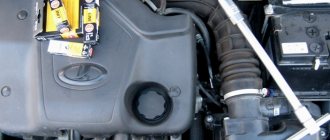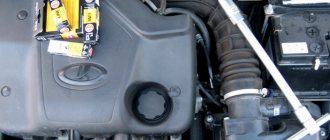Spark plug gaps Kalina 8 cl
We replace spark plugs as recommended by the manufacturer every 30,000 km or if they fail if the engine begins to operate unstably at idle.
To complete the work you will need: 16 mm socket wrench for spark plugs with an extension. A rubber coupling must be installed in the head of the key to hold the spark plug.
1. Remove the ignition coil of the first cylinder.
2. 16 mm socket wrench for spark plugs, unscrew the spark plug and remove it from the socket.
3. Remove the spark plug from the key head.
Adjustment
4. Before installing the spark plug, use a set of round feeler gauges to check the gap between its electrodes. The gap should be 1.0 -1.1 mm.
When checking the gap with flat feeler gauges, the measurement results will be incorrect.
5. We adjust the gap by bending the side electrode.
To avoid damaging the threads in the cylinder head, the spark plug should first be screwed in by hand and then tightened by inserting the wrench into the wrench extension. The tightening torque of the spark plug is 30-40 Nm.
We insert the spark plug into the head of the key and screw it into the cylinder head.
We replace the spark plugs of the remaining cylinders in the same way.
ENGINE 11183 1.6L 8-valve JSC AvtoVAZ, the engine is known to car enthusiasts under the names: 11183; engine 21114; 2114; Kalina motor; motor Kalina, etc. VALUE Cylinder displacement, cubic meters. cm - 1.596 Rated power, l. With. (at 5200 rpm) - 82 Maximum torque, Nm (at 2700 rpm) - 120 Number of cylinders - 4 Number of valves per cylinder, pcs. — 2 Total number of valves, pcs. - 8 Cylinder diameter, mm - 82 Piston stroke, mm - 75.6 Spark plugs - A17 DVRM, BPR6ES (NGK), etc. Cylinder operation diagram - 1 - 3- 4- 2 Power system - Injector (distributed injection with electronic control) Fuel Unleaded gasoline AI-92 Fuel consumption, l./100 km. (city/highway) - 8.8/5.7 Lubrication system Combined (splash + under pressure) Type of engine oil - 5W-30, 5W-40, 10w-30 and 10W-40 Amount of engine oil, l - 3.5 Cooling system — Liquid, closed type Coolant — Based on ethylene glycol Motor life, thousand hours. (theory/practice) - 150/300 Weight, kg - 127
Car problems: 1-Reduced speed and traction for a couple of seconds. 2-On gasoline (there is still gas) it makes a little noise... 3-In the dark there is a bright ring of breakdown around the spark plug insulators.
Old high-voltage wires: Tag-No. 9216 01/21/13 13:03:54 PES/SCC SAMARA RUSSIA On the other hand: PES/SCC RUSSIA SAMARA 2190 3707080 rev.00C Wire resistance. 1-5.5 kOhm 2-4.7 kOhm 3- Does not show, infinity. 4- 3.2 kOhm
I bought new high-voltage wires: high-voltage wires with 8 valves. "Milena" 2111-3707080 For all fuel-injected VAZ cars (8kL) Resistance up to 7 kOhm How to connect.
AVTOVAZ's recommendations for spark plugs are as follows: Applicability of spark plugs for VAZ cars.
JSC ZAZS, Russia A17DVRM BERU, Germany 14R-7DU CHAMPION, England RN9YC NGK, Japan BPR6ES DENSO, Japan W20EPR BRISK, Czech Republic LR15YC BOSCH, Germany WR7DC
JSC ZAZS, Russia - AU17DVRM BERU, Germany - 14FR-7DU CHAMPION, England - RC9YC NGK, Japan - BCPR6ES DENSO, Japan - Q20PR-U11 BRISK, Czech Republic - DR15YC BOSCH, Germany - FR7DCU
Effect of gap on ignition
To understand how this factor affects the efficiency of a gasoline engine, you need to briefly consider the operation of the ignition system. The algorithm for converting fuel energy into mechanical work looks like this:
- Having released the exhaust gases through the valve into the cylinder head, the piston moves downwards. When it reaches the lowest point, the second valve opens, from where the air-fuel mixture enters the cylinder.
- The piston rises to the combustion chamber and compresses this aerosol several times.
- At the moment when the piston crown is at top dead center, a high-voltage pulse is applied to the spark plug electrodes. A spark jumps between them, igniting the compressed mixture of fuel and air.
- Burning at a certain speed, the fuel releases energy that pushes the piston down. Mechanical work is performed.
- The last stroke is the release of combustion products into the exhaust system, after which the cycle repeats.
A high voltage pulse (over 20 kilovolts) is generated by a coil based on a signal from the controller. Its winding is designed to generate a spark of a certain force, sufficient for high-quality ignition of a portion of the fuel mixture. If the gap in the spark plugs is too large or small, the combustion process will be disrupted.
Large gap between electrodes
A gap greater than 1.3 mm is considered abnormally large. What happens if the electrodes are extended to this extent:
- the coil power is not enough to spark an increased distance with each compression stroke, skipping cycles will appear;
- the operation of the power unit will be unstable and vibration will appear;
- one part of the unburnt gasoline will flow down the cylinder walls and enter the crankcase, the second will be thrown into the exhaust tract;
- fuel consumption will increase;
- Carbon deposits quickly form on the walls of the combustion chamber, the piston bottom and the working elements of the spark plugs.
Note. The higher the engine speed, the more misfires there will be, and the proportion of wasted gasoline will increase. The engine oil in the crankcase will begin to liquefy and release flammable vapors that enter the chamber through the breather pipe and air path.
As a result of the above processes, the engine will not deliver full power, and the cylinder-piston group will wear out faster in the long run. Too large a gap affects the quality of fuel combustion, you will feel this while driving: car acceleration will be sluggish, and engine vibration will be increased. Due to skipping cycles, problems with cold starting will appear - the engine will start after several attempts.
Interelectrode distance too small
A distance between spark plug contacts of less than 0.6 mm is considered unacceptably small. True, skipping work cycles will not be observed, but another problem will arise - too weak ignition. A short spark that breaks through a small gap from one electrode to another is not capable of properly igniting the air-fuel mixture, which occupies the entire volume of the chamber.
Due to the reduced burning rate, the air-gasoline aerosol will not have time to burn out entirely before the stroke of the piston begins, and then the exhaust gases are released. As a result, the consequences described above occur - a drop in the power of the power unit, increased fuel consumption, soot in the exhaust and carbon deposits inside the cylinders.
Incorrect adjustment of the spark plug gap is often aggravated by other factors: wear of the piston group, problems in the fuel supply system, broken insulation of high-voltage wires, and so on. Then the problem of adjusting the gaps recedes into the background and often falls out of sight of the car enthusiast.
Ceramic deposits have appeared - change the spark plugs immediately!
In terms of their operational parameters, including durability, all components of the listed items are almost the same from each other. This is confirmed by reviews from car owners expressed on various forums, etc. Perhaps there are more expensive components, the use of which will allow a simple replacement to increase power, engine torque or some other characteristics. But having installed such spark plugs in the 21126 engine, you will most likely have to forget about the warranty on the AY-K3 gearbox. It’s always like this with technology: we need to imagine what exactly we are doing and what we want to achieve as a result.
Indications for replacing spark plugs:
- If there is black soot (“suede”) on the insulator cone and electrodes, then cleaning or replacement can be done. Cleaning is carried out, among other things, by heating. When replacing, it is better to use spark plugs with a slightly lower heat value than before;
- If the surface of the insulator looks like yellowish glossy ceramic, then the spark plug needs to be replaced. In this case, a glassy glaze is formed. It is electrically conductive.
In the first of the cases considered, carbon deposits are formed because not all elements of the candle are heated sufficiently, and self-cleaning does not occur. This can happen when the car is used for short trips with low speeds and frequent starts and stops. The same effect is typical for operating the motor at low temperatures. Logically, in such situations, the recommended replacement would be a spark plug with a lower heat rating than what was intended by the manufacturer. You can try installing A14DVRM spark plugs instead of A17DVRM in an 8-valve engine, and so on. Only now, such a replacement must be discussed with the dealer.
Reducing and increasing the gap
When the engine is running, spark plugs also perform their functions. Accordingly, it is possible for them to decrease or increase the interelectrode length. Different results are possible regarding the nature of the gap.
If the gap between the spark plug electrodes is reduced, the following consequences appear:
- The power of the spark increases, but it becomes short, which is reflected in the inability to influence the combustible mixture. As a result, a flood of spark plugs occurs, which affects such a phenomenon as “the car begins to stall.”
- The likelihood of an electric arc forming at high speeds increases. This is due to the fact that a spark obtained at a small electrode distance does not have time to explode. Therefore, there is a continuous flow, affecting the operation of the motor and coil, in which a short circuit may occur. Such moments entail the replacement of many parts.
The results of a small gap of electrode elements imply repair of the engine and its components.
Comparison of A17DVRM analogues produced under different brands
One of the online publications conducted a comparative test of spark plugs intended for the VAZ-21116 engine. We tested analogues of the A17DVRM spark plug, supplied by the following companies:
- APS, Bosch, Brisk – Russian production;
- Bosch Platinum, Beru, Finwhale – Germany;
- NGK, Denso – Japan;
- Eyquem - France;
- Champion – “made in the European Union”.
Note that testing was carried out on an 8-valve VAZ-2111 engine (injectors, lambda probe, without catalyst, “January-5.1”). All measurements were carried out on a bench.
Selection of spark plugs for 8-valve engine 21116
The results of the tests performed are presented in the photo in the form of graphs. As you can see, it still makes sense to buy imports: using spark plugs from Bosch, as well as products from the Finwhale, Brisk and Champion brands will provide a noticeable increase in power. If you want to save on fuel, then ask for NGK products in stores. Additional comments are unnecessary here.
Gap size
What is the spark plug gap based on vehicle type? The clearance between the contacts is different for different brands of cars. For cars currently produced, a certain spark plug gap is typical. Therefore, engine manufacturers do not recommend adjusting the distance yourself.
Regarding Russian-made cars produced in past years and today, the interelectrode length depends on the quality of the motor. If there is a carburetor type with a contact type of ignition, then the value corresponds to the interval of 0.5-0.6 mm. For contactless ignition, the indicator is reduced to 0.7-0.8 mm. In the situation of an injector, an intermediate length of 1.0-1.3 mm is maintained.
About candles
The spark plug in the engine is a very important element, without which the internal combustion engine simply will not work. At the moment the spark is applied, the fuel mixture in the combustion chamber is in a compressed position, when a spark appears, the mixture ignites and an explosion occurs, thereby pushing the piston down. The spark plug serves as a link between the ignition coil and the combustion chamber.
The difference between candles
Two types of engines with 8 and 16 valves were installed on the Lada Kalina. The type of spark plugs depends on the number of valves. The difference between the spark plugs in a 16-valve engine is the smaller diameter of the hexagon, since these spark plugs are placed in the spark plug well, where there is a rather narrow distance from the walls, which does not allow the use of spark plugs with a 21mm hexagon.
Spark plugs from a 16-valve engine can be installed on an 8-valve engine, but vice versa will not work, spark plugs from an 8-valve engine will not fit into the spark plug well.
Candle device
Normal clearance size
The permissible limits of the interelectrode distance are from 0.6 to 1.2 mm. A more precise value is selected depending on the type of engine, power supply and ignition system:
- old-type carburetor engines with a low compression ratio and a mechanical spark generation system - 0.6–0.7 mm;
- the same engines equipped with non-contact electronic ignition – 0.8–0.9 mm;
- in turbocharged and naturally aspirated power units with fuel supplied by injection (injector), the gap on the spark plugs should be from 1 to 1.2 mm.
Advice. The best way to correctly determine the interelectrode clearance for a particular vehicle is to carefully study the operating instructions. In the vast majority of cases, this value is indicated among other setting parameters.
Since the owners of many vehicles equipped with gasoline engines switch to liquefied gas, the size of the spark plug gap requires adjustment. For high-quality combustion of a mixture of propane and air, it is recommended to increase the ignition intensity by increasing the clearance by 0.1 mm from the rated value. The load on the high-voltage coil will increase slightly, and the gas will burn better.
When is it necessary to replace spark plugs?
The replacement of spark plugs is carried out no later than 40,000 km, since by this mileage the wear of the insulators on the spark plugs is already quite decent, and the temperature may increase the gap between the contacts, which will lead to incorrect operation of the spark plug.
You should also first replace the spark plugs if misfires are detected in the cylinders or unstable engine operation, interruptions in operation and loss of power.
The concept of electrode gap and its purpose
The spark plug has a pair of contacts. The first is the positive central electrode, and the second is the negative side electrode. The central contact is a link in the chain of supplying current from the ignition coil. The side element is shorted to ground. A spark appears between these elements during the movement of the pulse. Thus, its characteristics are directly dependent on the distance between these two electrodes.
Depending on the type of engine, fuel quality, and power, certain spark plugs should be selected. These spark plugs are recommended by car manufacturers. If you want to use such elements intended for one car on a vehicle of another brand, then this will not work. Since the gap between the contacts is an important quality of spark plugs.
The distance between the electrodes affects the following properties of the motor:
- Stability of operation;
- Developed power;
- Number of maximum revolutions;
- Fuel consumption;
- Duration of operation of many parts.
Therefore, it is worth periodically assessing the interelectrode distance. As a result, based on the mileage on the spark plugs used, judge whether to replace parts or the possibility of increasing (decreasing) the gap.
HOW TO REPLACE CANDLES FOR VAZ 2170, 2171, 2172 LADA PRIORA WITH YOUR OWN HANDS.
If you have everything, then you can proceed:
1. First, remove the decorative plastic casing.
2. Next, disconnect the ignition coil terminal.
3. Unscrew the coil mounting bolt.
4. Using a flathead screwdriver, remove the ignition coil.
5. The spark plug is located in a recess, in the so-called spark plug well, so to unscrew it you will need an extension cord.
6. Be careful, if you notice traces of oil in the spark plug well, be sure to find out its origin; the engine may need immediate replacement of the cylinder head gasket.
7. If this is your first time replacing spark plugs, then it will take some effort to unscrew the spark plugs; in some cases it is simply impossible to do this with a simple spark plug wrench. To do this, you will have to buy a special spark plug socket with a knob.
Symptoms of replacement
The process of replacing spark plugs is quite simple and can be done independently.
According to the manufacturer's regulations, spark plugs must be replaced every 30,000 km . However, in the harsh Russian realities, not every detail is able to work out the time allotted to it.
The following signs indicate the need to replace spark plugs:
- The starter spins longer than it should when starting the engine.
- Gasoline consumption has increased.
- Extraneous sounds are heard from the engine during the warm-up process. Why does the engine take a long time to warm up?
- Reduced motor power . This is especially noticeable when trying to drive up a mountain.
- The spark plugs are "wet from gasoline".
That is, they are flooded. To check, you need to unscrew the spark plugs and inspect them. Too uneven carbon deposits on the electrodes of the spark plugs indicate problems in the operation of one or another cylinder.
Soot on spark plugs does not always indicate that they need to be changed. If the mileage is still low, then the consumables can be cleaned. For example, a gray-yellow or brown coating indicates that the electrodes are not very worn.











